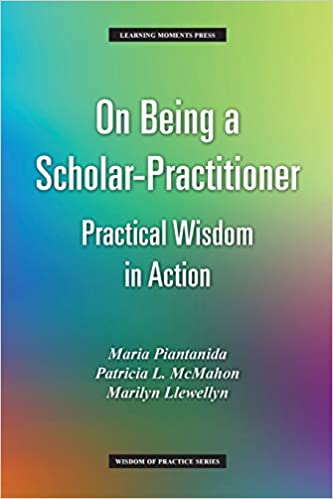Practical Wisdom for Scholar-Practitioners
On Being a Scholar-Practitioner: Practical Wisdom in Action
By Maria Piantanida, Patricia L. McMahon, and Marilyn Llewellyn
(Learning Moments Press, 2019 – Learn more)
Reviewed by Megan Reister
As a professor of special education and a teacher educator, I actively strive to provide meaningful and teachable moments inside and outside the classroom. On Being a Scholar-Practitioner will help me do that. The trio of authors introduce and summarize what it means to be a Scholar-Practitioner and to use practical wisdom as we pursue our professional practice.
Piantanida, McMahon, and Llewellyn skillfully share research and timely topics, with their own experiences as researchers and college instructors of teacher preparation programs carefully interwoven into the narrative.
As the book progresses, they do a wonderful job of carrying their themes forward, revisiting earlier topics to remind the reader of what was shared in previous chapters and providing scaffolding as they link previous material with newer points that are being made.

The authors skillfully bring the reader along as they build off the definition of Scholar-Practitioner and bring in the importance of relating to others, making dialogue the goal of communicating, and considering the consequences of our teaching decisions for the good or for the detriment of our students.
Thinking of pre-service teachers
The most important aspects of the book for me, as a professor who works closely with pre-service educators preparing to teach in a variety of settings and licensure areas, are: the readability (in case I have my students complete assigned readings from the book); the reflective questions that are available at the end of the chapters as prompts to guide the students’ thinking; and the vignettes or personal examples of catalyzing moments that are shared.
These real world application examples will go a long way in allowing my students to see the content of the book can be applied in a future hypothetical setting that could very well happen for them in their careers
Lessons for me as well
Even though I initially started reading this book with the perspective of what it could provide my students in the higher education setting, I found myself being drawn in and learning and growing as a Scholar-Practitioner myself as I pondered my openness as a teacher and how I embrace (or maybe do not always embrace) pedagogical moments that occur in the classroom.
One can never be reminded too often of the importance of being vulnerable and authentic, and the authors of the book touch upon those themes as they ponder how being open to change and recognizing the impact actions have on others in teaching can lead to more effective instruction.
Professional self-examination is not for the faint of heart. It requires a willingness to be vulnerable, to admit mistakes, to question taken-for-granted assumptions, to feel foolish, to look honestly at oneself. It requires doubt and humility. “It is far better to develop as a Scholar-Practitioner if [the teacher] is able to accept his/her own fallibility and to embrace a stance of learner. As hard as it may be, pedagogical moments that have gone awry are often the best clues to the learning we need to pursue.”
Elements worth sharing
I am very excited to share with my students resources from this book. For example, pre-service and in-service teachers must always consider the objective or end goal of the learning experience and seek to balance the needs of the many with the needs of the one. This especially rings true for me as a special education teacher and a person with a special need! The examples provided in this section of the book were applicable and thought provoking, inviting readers to consider how they might address the problem or situation being described on the pages.
As one who covers systematic direct instruction in one class and inquiry-based instruction in another, I especially appreciated Chapter 6 that reviewed different theoretical lenses for thinking about curriculum structures in an easy to understand and follow format. I am already planning to share certain pages from the chapter with my students to help them see the differences between these curriculum structures. The detailed yet succinct ways in which each structure was explained will help my students to clearly recognize and analyze the differences and characteristics of each.
A call to action for Scholar-Practitioners
The authors raise pertinent, timely, and relevant questions. Their call to action is inspiring as readers consider their own roles as Scholar-Practitioners and how they will leave a mark on the discipline of education.
Aesthetically speaking, the cover of the book itself is very pleasing to the eye with the muted colors evoking a sense of calm. The page layout, along with the chosen figures and diagrams selected for publication, is conducive to ease in reading and perceiving the information that is presented.
If you are looking for a book that provides a realistic yet hopeful view of what it means to be an educator and a researcher by way of viewing oneself as a Scholar-Practitioner, then this book fits the bill. At just under 300 pages, On Being a Scholar-Practitioner provides the reader with an overview of some of the big challenges that exist within education today yet offers inspiration and spurs change by helping the reader to see himself or herself as an active change agent in the education landscape. I will definitely be sharing passages from this book with my pre-service educators in future classes!
Dr. Megan Reister is Associate Professor of Special Education & Early Childhood Education at Franciscan University of Steubenville in Ohio. Formerly a hearing itinerant and special education teacher for eight years, she now researches advocacy for children with hearing loss and co-teaching/parent collaboration while working with preservice teachers.


































